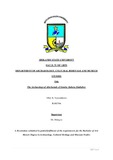Please use this identifier to cite or link to this item:
https://cris.library.msu.ac.zw//handle/11408/3368Full metadata record
| DC Field | Value | Language |
|---|---|---|
| dc.contributor.author | Nyakunhuwa, Obey K | - |
| dc.date.accessioned | 2018-11-21T07:29:24Z | - |
| dc.date.available | 2018-11-21T07:29:24Z | - |
| dc.date.issued | 2018 | - |
| dc.identifier.uri | http://hdl.handle.net/11408/3368 | - |
| dc.description.abstract | Most late Iron Age societies have been studied through the study of burials and their associated grave goods. This has been proven to be a significant source of archaeological record. Some of the sites that have been discovered like Mapungubwe have been understood from burials that were found. Through the associated grave goods the research is going to characterise the grave goods of burials from Gombe in Buhera Zimbabwe to understand issues of status, social organisation and negotiation of power of the people who lived and used Gombe. Looking at Buhera there are researches that have been done but most of the researches have been interested in pottery of that region. This research comes in with a different approach in understating one of the sites found in Buhera which is Gombe ruins by studying burials that are found there and such sites their burials have not been found the research tries to infer into the grave goods to understand conceptualization of power, wealth and social classes in death. These issues are going to be understood from an archaeological approach and ethnographic approach is also included to have a better understanding of the grave goods, interviews and observations were used to inquire the information needed to achieve the aim of the research. There are a number of issues that can be understood from studying burials of the prehistoric societies these are political organisation, economic and social organisation of the prehistoric societies. One can also understand the issue of status among the prehistoric societies through the study of burials and their associated grave goods in most prehistoric societies in Zimbabwe archaeologist have been able to infer into issues status using grave goods and different models have been used to interpret the material culture that has been found in association with burials | en_US |
| dc.language.iso | en | en_US |
| dc.publisher | Midlands State University | en_US |
| dc.subject | Status | en_US |
| dc.subject | Grave goods | en_US |
| dc.subject | Social organisation | en_US |
| dc.subject | Negotiation of power | en_US |
| dc.subject | Archaeological approach | en_US |
| dc.title | The archaeology of elite burials of Gombe, Buhera Zimbabwe | en_US |
| item.fulltext | With Fulltext | - |
| item.grantfulltext | open | - |
| item.languageiso639-1 | en | - |
| Appears in Collections: | Ba Archaeology, Cultural Heritage And Museum Studies Honours Degree | |
Files in This Item:
| File | Description | Size | Format | |
|---|---|---|---|---|
| 2018 DISETATION OBEY.pdf | Full Text | 909.08 kB | Adobe PDF |  View/Open |
Page view(s)
208
checked on Dec 18, 2025
Download(s)
134
checked on Dec 18, 2025
Google ScholarTM
Check
Items in MSUIR are protected by copyright, with all rights reserved, unless otherwise indicated.



